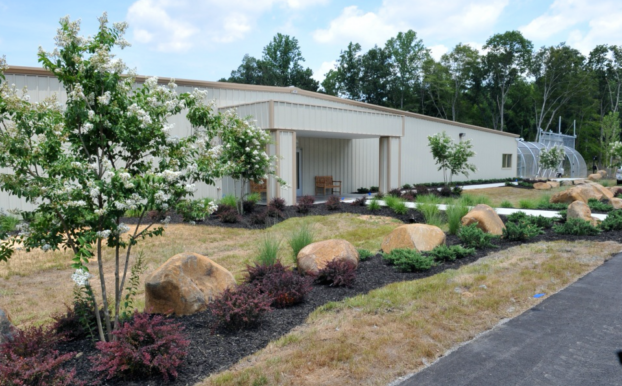Detention Center: an inside look
Published 7:00 am Wednesday, November 27, 2019

- A look at ICA Farmville, where detainees await immigration proceedings. (photo by Paul Caffrey)
On Nov. 12 The Herald was invited on a tour of the Immigration Centers of America (ICA) Farmville Detention Center. The tour served as an inside look of the day-to-day operations of the facility.
On its website, the detention center states that its mission is to “provide a safe, humane and appropriately secure civil detention environment that offers an appealing alternative to the standard method of detention for federal immigrants while they navigate the immigration process.”
The facility, according to Farmville Detention Center Director Jeff Crawford, contains enough beds to house up to 736 detainees, although the number fluctuates from day to day. 576 individuals were being housed at the facility on Nov. 12, falling from a headcount of 650 the week prior. Detainees are all male and range in age with an average age of mid-30s. A typical day shift includes 28 officers on duty, and a night shift sees an average of 25 officers. The detention center as a whole has approximately 180 employees.
Inside the facility is a central control center, which Crawford describes as his biggest single asset. Individuals operating the control center can control doors and screens, answer phones, move cameras and survey the entire detention center. According to Crawford, there are no places in the facility in which detainees have access that do not have video surveillance.
Beyond the central control center is a “court” room containing four cells in which detainees can attend immigration court in Arlington or Alexandria through CCTV. There is one TV per cell in this room, meaning that up to four detainees can attend court at the same time.
Venturing through another door reveals the central booking room, in which detainees are processed, searched, evaluated by a nurse and receive orientation. Most cells in the central booking room only temporarily house detainees going through the booking process, although some cells house detainees living alone in cells known as “segregation units.”
The detention center contains a medical unit with 14 housing beds and three negative pressure cells for communicative diseases. In these cells air is ventilated upon exhalation. Crawford highlighted that for some individuals at ICA, this is the first medical care that they have ever received in their lives.
The facility contracts through Armor Correctional Health Services, with 32 medical staff including one full time doctor, a dentist, one full time dental assistant and two licensed counselors. There are anywhere between four-five nurses on duty during the day and two-three on duty at night.
Many detainees spent time in the medical unit after an outbreak of mumps at the detention center in June. Crawford stated that many inmates were done with their immigration cases but could not leave due to being quarantined at the time of the mumps outbreak. The facility offered the MMR vaccine, which protects against measles, mumps and rubella to all of its detainees at the time, with approximately 700 individuals opting to receive the vaccine and only a handful declining.
The detainees are screened by a nurse upon arrival at the detention center, and some already have a medical history on file from previous arrests. 10% of detainees at the facility are chronic care patients with conditions such as diabetes or asthma.
The medical unit includes one padded cell and one suicide observation room, where detainees that are believed to be at risk of suicide are temporarily held. Detainees held in this room don a “suicide smock” made of material that cannot be twisted. The cell contains a bed made from the same material. Crawford cited that four detainees had been placed in the suicide observation room for a period of time within the last month. He also stated that the facility has seen two suicide attempts by detainees within the decade, although the number rose to three after an individual attempted to take his own life later that afternoon on Nov. 12. No suicide attempt at the facility has ever been successful.
Detainees throughout the facility wear differently colored jumpsuits that correspond with the individual’s custody level. Yellow jumpsuits signal an individual of low level, light blue indicates a medium level, a green jumpsuit corresponds to a medium high level, an orange suit signals a high level, and detainees wearing a red jumpsuit are individuals that have been placed into segregation from all other detainees. High and low-level custody detainees never cross paths at the facility.
The detention center’s kitchen is run by Jeff Smith of Trinity Service Group. Smith spoke highly of the facility’s food, stating that detainee’s meals are nothing like what might be found at a typical jail or prison. Smith himself eats the same food as the detainees, as do many of the officers. Lunch on the date of the tour included a baked chicken leg, green beans, potatoes and a salad. Smith added that his one complaint about the food was its lacking in salt. Detainees receive three square meals a day and are allowed to add salt and pepper to their meals, and through this the facility goes through 50 pounds of salt every week.
Detainees can apply for jobs in different sections of the facility in order to bide their time and make money that they can spend at the center’s commissary. The most highly-sought after job at the center is the morning kitchen shift beginning at 3 a.m., where detainees can make $1.85/hr working in the kitchen and preparing meals via an assembly line. Detainees can find work by cutting hair for $1.45/ hr at the center’s own barber shop, work in the laundry room, etc. The lowest-paying job at the center is $0.40/ hr, although the minimum pay requirement for any Immigration and Customs Enforcement (ICE) facility in the nation is only $0.08/hr. Detainees can buy anything that they wish at the facility’s commissary, although all of their possessions must fit into a personal property storage unit. Detainees can also receive funds from anyone outside of the facility via an accessible account that money can be deposited into.
Inside of the facility is a leisure library in which detainees can check out books. As a majority of the detainees speak Spanish, the detention center makes an effort to find books in Spanish at used book fairs. The Mexican Consulate has donated books to the center in the past.
In addition to books, the library also contains a computer that supports LexisNexis, a program that allows detainees to research law and better understand the U.S. court system. According to Crawford the facility used to have multiple computers in the library, but gang-affiliated detainees began using time at the computer to correlate meetings and pursue gang-related activities.
Although there are some detainees that request to live in segregation units, the majority reside in dormitories. The detention center has nine open dorms, the largest of which can house a maximum of 102 individuals and the smallest of which can house 44. The dorms include air conditioning and heating, a space for video visitation and LexisNexis access, a phone, and a wall of resources such as consulate numbers.
The detention center occasionally brings out extra cots for the dorms if they see an influx of detainees. Crawford cited that during the Brazilian Olympics of 2016, an influx of Hatians came to Brazil in order to find work. After the Olympics were over, many Hatians did not return home and instead came illegally into the U.S. As a result, the facility received 200 Hatians.
A quick trip outside takes detainees to a cluster of buildings for recreational activities. One such building includes a chapel. The chapel, operated by two-full time chaplains and volunteers from the area, sees multiple services every day. While the majority of detainees are Christian, the chapel includes prayer rugs for Muslim detainees and an effort is made to accommodate for all detainees’ religions. Inside the chapel detainees can also take guitar classes and play the piano and drums. During the tour, many detainees eagerly shook the chaplain’s hand as they exited the chapel.
Detainees receive four hours of outdoor recreation time per day, and the facility has four outdoor recreation pens that can have up to 100 people in each pen. There is also an indoor recreation building similar to a gym that detainees can use when the weather is poor and have full access to throughout the night. Detainees can exercise for as long as they want during the nighttime in order to burn off steam.
Beside the indoor rec room is a multimedia room that detainees can access for two hours a day every four days. Here detainees can listen to their own personal radio station of approximately 18,000 songs, and visitors can sometimes tune into this radio in the parking lot. Once a week, individuals can use a gaming library with Xboxes and a variety of video games. Crawford remarked that he had originally bought several replacement controllers for the gaming systems, but has not had to use them as the detainees take such good care of these items.
Visitation hours at the center are from 9 a.m.-9 p.m. every day of the year. However, the facility will allow family or friends to visit at any hour of the night if notified at least 24 hours in advance. Students from Longwood University come four nights a week to teach detainees in classes such as art or English as a second language. Detainees also have access to a grievance officer.
Additionally, the facility offers classes to the detainees such as “lifestyle choices” or “anger management.” There is also an alcoholics anonymous group for detainees, although this also serves as a resource for detainees that have other addictions like drugs. Crawford stated that the facility seizes drugs from detainees inside the center around two times per year, although he has recently seen an increase in gang-affiliated drug busts. The main drugs found in the facility are marijuana and cocaine, and the center does random drug tests on both detainees and staff.
When asked if he had plans for expansion of the facility, Crawford stated that the detention center desires to build a large segregation unit. When a detainee asks to be segregated from other detainees, the facility must oblige this request in order to protect the detainee’s safety. The average stay in a segregation unit is eight days. If all segregation beds are full, however, the facility cannot accept any new detainees in any of the dormitories, regardless of whether or not new detainees may want to be segregated from others. Although the facility currently has only four official segregation beds, they would like to add 96 more, well above the industry recommendation of 10%.
Crawford reported that the facility does often have to use force on some detainees and averages 30 pepper spray uses a month. Only one detainee has died in the facility’s custody since its opening. In 2011, a young man collapsed within days of being at the detention center and was taken to a hospital where he died from liver complications due to alcohol abuse.
ICE Deputy Field Officer Lyle Boelens was also present during the tour and sat down for an interview with The Herald in order to highlight the purpose of ICE-contracted facilities like the Farmville Detention Center.
“We have individuals who are going through immigration proceedings or who are going to be removed in the reasonably foreseeable future, and they are detained here in order to ensure compliance,” explained Boelens. “They are not detained for punitive reasons. We detain individuals as they go through proceedings in order to remove them. If there is some indication that we are unable to execute that judge’s removal order then we will reconsider their detention. We do not keep people in detention without there being a removal goal at the end.”
Boelens stated that ICE has two major factors that they consider as to whether or not someone should be kept in detention during their removal proceedings. “That is the likelihood that they might be a flight risk; that they might abscond and not go before the judge, and then they are a threat to public safety. If they have committed serious enough crimes then they are recidivist, then we will often detain them for public safety reasons.”
Boelens explained that while the Farmville Detention Center only detains men, female detainees are kept at a second detention facility that ICE contracts with in Caroline County. There are also a few ICE family centers scattered around the nation, such as in Berks County, Pennsylvania, where families are kept together. The majority of Farmville’s detainees, Boelens highlighted, come from the countries of Mexico, Honduras, Guatemala and El Salvador. The facility also tends to see a significant number of individuals from African and Asian countries.
“I think this facility is probably on the higher end in terms of offering services to the detainees here,” Boelens said in reference to Farmville’s center. “… I would say Farmville has been a leading facility nationwide in terms of providing services to detainees.”





